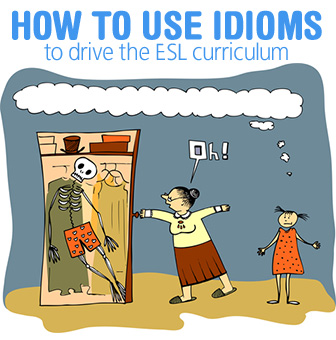Is it Run-Around? Run-About? Round-About? Teaching Self-Editing for Idiom


An interesting title, actually, as it was definitely an American program, set in New York City, but the idiom “mad about,” in the sense of “to like” or “to love” very much, is British English; Americans are more likely to say “crazy about.” Once in class when I was briefly recounting an episode from the show—discussing plots of TV shows is actually good conversational practice as they are usually uncomplicated and easy to follow—my students appeared confused, and I couldn’t understand why, as the plot was not difficult. One of the students finally spoke up: “I don’t understand if the show is about love and marriage it’s called ‘Mad about You.’ Doesn’t that mean they’re angry, hate each other, might divorce?” Oh, I understood now. “No, Jaime, not ‘mad at’ you but ‘mad about’ you, something completely different.” It was strange how one word can change completely the meaning of an idiom. And actually there are quite of few these that can potentially be confusing, especially the more figurative the expression is—that is, the more it is removed from tangible experience. Often idioms or word combinations have both a literal and figurative meaning; others have only the figurative, idiomatic meaning, and some were once literal in nature, but the literal meaning is no longer in use. So there are several potentially confusing levels in idioms to watch out for in instruction: teaching the correct combination of words for the correct meaning and teaching both figurative and literal meanings.

This is one of those idioms that has both literal and abstract meanings: it can mean literally to turn around while driving or walking and go in the opposite direction. It also means, figuratively, to change oneself or one’s life completely: “I really need to turn myself around” or “We really need to turn around this project.” The expression is heard frequently in the U.S., not surprising in a culture with a strong belief in the positive value of change. (President Obama ran his first very successful campaign on a theme of change.) The figurative “turn around” is related to the literal one: if I want to turn around my life or my relationship, I want in some way to go in the opposite direction.
This is another idiom that has both literal and figurative meanings. In a couple weeks in California, we will set back our clocks as we do every fall as we go off daylight savings time. This is the literal meaning: we physically take our clocks or watches and set them back one hour. “A setback, “however, the noun form, means a disappointment or loss: “Her layoff from her job was a real setback for her and her family.” Again, the literal and figurative meanings are closely related in that a life setback almost sets one back in time to an earlier point before having what was lost.
This means to keep something in mind or to remember it: “Bear in mind, on Friday we are updating the software, so plan accordingly because the computers will be offline.” There is no literal equivalent to this, except that one meaning of “to bear” is to carry, so if you “bear something in mind,” it is as if you are carrying it the way you might “bear arms,” or a carry a weapon, for example.
This idiom means to avoid the main point, to evade. It is most often used in imperatives: e.g., “Don’t beat around the bush,” or “Stop beating around the bush! Tell me what you mean.”
The popularity of the expression in the U.S. might show the importance of directness in the culture and impatience for indirectness. Its connection to a literal meaning seems to have disappeared but may be related to hunting: a hunter who “beats around the bush” hits with his stick only the outside of the bush instead of attacking the center, where snakes and other trouble may hide.
This idiom means to get accustomed to a routine or practice: “He had some trouble with his new job, but now he’s really gotten into the swing of it.” the expression seems to be drawn from dance: if I get into the swing of a new dance, I am dancing in rhythm to the music and the rest of the dancers.

Idioms are difficult to learn so require careful instruction. By following certain practices, however, students can learn these important expressions.
Begin by defining the idiom in question and connect the figurative meaning to the literal one, if possible: e.g., connect “miss the boat,” literally, to be left standing on the pier as the boat sails, to “miss the boat” figuratively: to miss out on some key point or opportunity. Students will usually readily see the connection, which will help them learn the idiom. Have them discuss the different meanings in groups. This is also a perfect time to discuss usage, how we actually use these idioms. For example, I might say, “I really missed the boat on that point, and I am sorry.” I would probably not say, “The boat was missed by me there” or “That country has missed the boat in this process” as the idiom is used in the active voice and applied to individuals.
As we saw with “mad about” and “mad at,” correct combinations of words are important, and one word can make a difference. Have your students do some fill-in-the-blanks to practice correct combinations of words for context: e.g.: The couple really love each other; they are mad ____each other.
Correct usage, how we actually use this language in context, is important to learn to avoid potential embarrassing or even dangerous mistakes: for example, I might tell husband to “stop beating around the bush”; I would avoid this language with my boss as it is too informal for the relationship.
A very good way for students to practice idioms is in journals for writing and dialogues for speaking. You may assign a journal, possibly a topic, and tell students to use at least three idioms in their journals. The instructor can then mark the journals for correctness in grammar, word combinations, meaning, and usage.
They are difficult to learn due to their figurative nature; however, with a focus on form and usage as well as practice, your students can be using them in no time!